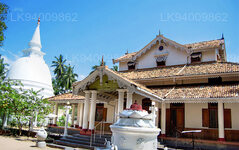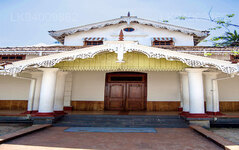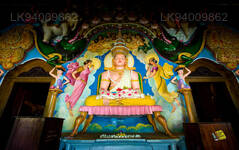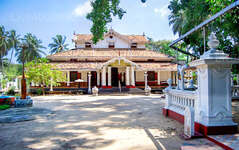
Ville de Colombo
Colombo, capitale du Sri Lanka, est une ville dynamique mêlant tradition et modernité. Elle met en valeur son architecture coloniale, ses marchés animés et ses temples bouddhistes paisibles. Avec sa cuisine variée, son paysage urbain en plein essor et ses magnifiques plages, c'est un pôle d'attraction pour les affaires, la culture et le tourisme, offrant une porte d'entrée vers les merveilles du Sri Lanka.
Isipathanaramaya Temple
Colombo is Sri Lanka’s capital, the center of trade and commerce for the entire country. It’s also one of the most populated cities on the island. Walking through the streets of Colombo, its quite hard to remember that the capital is a comparatively young city. It’s oldest buildings are only a few centuries old at most, and not at all comparable to the millennia-old structures that spread across Anuradhapura, Polonnaruwa and many other places within Sri Lanka. Therefore, it comes as no surprise that its oldest Buddhist Temples are only a century old or so.
Isipathanaramaya located in Havelock Town (Colombo 05) is one such Buddhist Temple that’s one of the oldest within the city. It was built in 1916, by a wealthy merchant named Duenuge Disan Pedris in the memory of his late son Captain Henry Pedris, who had been executed by the British on false allegations of incitement of the racial riots in 1915.
As the story goes, that was the year of the Sinhala-Muslim riots that started in Kandy because of reports of a group of Muslims throwing stones at a Buddhist event. It spread across the island like wildfire, and British governor came to the verge of losing control of the population. He declared martial law, and ordered a death-without-trial order on any person deemed a rioter. Unfortunately the illustrious and well-known Captain Henry, had been the object of envy for many locals. One of them, Solomon Dias Bandaranaike, who was the main native translator decided to use this opportunity to get rid of this thorn that threatened his power. He created false charges that Henry was involved in the riots and the Captain was branded traitor and executed without trial. His body was buried in dishonor, much to the distress of his family. It was only several years later that the truth came out and the late Captain was cleared of his charges.
In the meantime, Henry’s grieving father – who had been having high hopes for his heir, built a temple in his memory on a 2 hectare piece of land that had been part of the family’s properties since 1905. He also did several other good deeds that would pass on the name of his son Henry Pedris down through history, despite his early death.
Duenuge Pedris spared no effort or money when building the temple. It was built with a mixture of traditional elements and the architectural trends of the era. The murals and statues that decorate the temple are a major part of Isipathanaramaya’s attraction. The paintings were done by Master Artist Sarlis in 1920-21, and are traditional designs of Buddhist religious significance. However, they have gained prominence due to the unique, exuberant and realistic style that was used.
The temple slowly gained fame. It reached such extent that in the 1950s the street that the temple was located – Greenlands Road, and the school down the same road – Greenlands College, received a name change to Isipathana Mawatha and Isipathana Maha Vidyalaya respectively.
Today, the overall layout of Isipathanaramaya remains in its original state, with its old colonial era building, brilliant white stupa, and shady Bo Tree. The main building is beautifully maintained preserving its history. One of the most recent additions was the 12m tall standing Buddha, built in 2016 at a cost of Rs 4.5 Million.
Isipathanaramaya is well worth visiting for its historical connotations and beautiful murals.
À propos du district de Colombo
Colombo est la plus grande ville et la capitale commerciale du Sri Lanka. Elle est située sur la côte ouest de l'île, à proximité de Sri Jayewardenepura Kotte, la capitale du pays. Colombo est une ville animée et dynamique, mêlant modernité, bâtiments et ruines coloniaux, et compte 647 100 habitants. La région métropolitaine de Colombo, définie par les districts de Colombo, Gampaha et Kalutara, compte une population estimée à 5 648 000 habitants et couvre une superficie de 3 694,20 km². Colombo est une ville multiethnique et multiculturelle. C'est la ville la plus peuplée du Sri Lanka, avec 642 163 habitants. La population de Colombo est un mélange de nombreux groupes ethniques, principalement cinghalais, maures et tamouls. On y trouve également de petites communautés d'origine chinoise, portugaise, néerlandaise, malaise et indienne, ainsi que de nombreux expatriés européens. La grande majorité des entreprises sri-lankaises ont leur siège social à Colombo. Parmi les industries présentes figurent les produits chimiques, le textile, le verre, le ciment, la maroquinerie, le mobilier et la bijouterie. Le centre-ville abrite le deuxième plus haut gratte-ciel d'Asie du Sud : le World Trade Centre. À propos de la province occidentale : la province occidentale est la plus densément peuplée du Sri Lanka. Elle abrite la capitale législative, Sri Jayawardenepura Kotte, ainsi que Colombo, centre administratif et commercial du pays. La province occidentale est divisée en trois districts principaux : Colombo (642 km²), Gampaha (1 386,6 km²) et Kalutara (1 606 km²). En tant que pôle économique du Sri Lanka, la ville accueille toutes les grandes entreprises locales et internationales, ainsi que les grands créateurs et les grandes enseignes. Préparez-vous donc à une séance de shopping dans la province occidentale. Avec la plus forte population de toutes les provinces, la province occidentale abrite la quasi-totalité des principaux établissements d'enseignement de l'île. Parmi les universités de la province, on compte l'Université de Colombo, l'Université de Sri Jayewardenepura, l'Université de Kelaniya, l'Open University, l'Université bouddhiste et pali du Sri Lanka, l'Université de défense générale Sir John Kotelawala et l'Université de Moratuwa. La province occidentale compte le plus grand nombre d'établissements scolaires du pays, comprenant des écoles nationales, provinciales, privées et internationales.










































